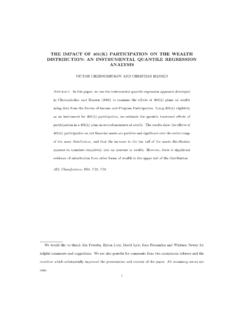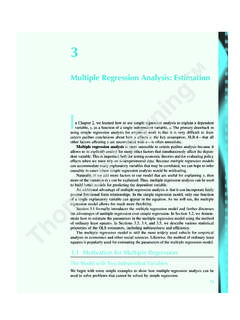Transcription of Ch.6 Multiple Regression Multiple Regression …
1 Chapter 06 Multiple Regression 4: Further Issues1 Econometrics1 Multiple Regression Analysisy = 0+ 1x1+ 2x2+ .. kxk+ u4. Further Multiple Regression : Further of Data Scaling on OLS on Functional on Goodness-of-Fit & Selection of & Residual analysis * Effects of Data ScalingRedefining VariablesChanging the scale of the variable will lead to a corresponding change in the scale of the coefficients and standard errors, but no change in the significance or interpretation. seetable Redefining VariablesIf xjis multiplied by c, its coefficient is divided by yis multiplied by c, allOLS coefficients is multiplied by tnor Fstatistics are affected by changing the units of measurement of any the variables appears in logarithmic form, changing unit of measurement does not affect the slope of Data ScalingEconometrics5 DependentIndependentycy yx1 1(se1)c 1(c*se1) dx1 1/d(se1/d)x2 2(se2)c 2(c*se2) 2(se2)Intercept 0(se0)c 0(c*se0) 0(se0)R-squaredR2R2R2 SSRSSRc2*SSRSSRS tandard errors in parenthesesEconometrics6 Beta CoefficientsIdea is to replace yand each xvariable with a standardized version subtract mean and divide by standard reflects standard deviation of yfor a one standard deviation change in x.
2 We can compare the magnitudes of the resulting beta coefficients and conclude that which variable is most important, etc. Whether we use standardized or unstandardized variables does not affect statistical significance. Chapter 06 Multiple Regression 4: Further More on Functional FormOLS can be used for relationships that are not strictly linear in xand yby using nonlinear functions of xand y will still be linear in the parameters. the natural log of x, yor both quadratic forms of x interactions of xvariablesEconometrics8 Interpretation of Log Modelsln(y) = 0+ 1ln(x) + u 1is the elasticity of ywith respect to xln(y) = 0+ 1x+ u 1is approximately the percentage change in ygiven a 1 unit change in xy= 0+ 1ln(x) + u 1is approximately the change in yfor a 100 percent change in xFunctional forms with LogarithmsEconometrics9 ModelDependentVa r i a b l eIndependentVa r i a b l eInterpretationof 1level-levelyx y/ xlevel-logylog(x) y/( x/x)log-levellog(y)x( y/y)/ xlog-loglog(y)log(x)( y/y)/( x/x)Econometrics10 Why use log models?
3 Log models are invariant to the scale of the variables since measuring percent give a direct estimate of models with y> 0, the conditional distribution is often heteroskedastic or skewed, while ln(y) is much less distribution of ln(y) is more narrow, limiting the effect of Rules of Thumb for log What types of variables are often used in log form? Dollar amounts that must be positive Very large variables, such as populationWhat types of variables are often used in level form? Variables measured in years Variables that are a proportion or percentEconometrics12 Quadratic ModelsFor a model of the form y = 0+ 1x + 2x2+ u, we can t interpret 1alone as measuring the change in ywith respect to x, we need to take into account 2as well, sincexxy21 2 + Chapter 06 Multiple Regression 4: Further Issues3 Econometrics13 More on Quadratic ModelsFor the case of the coefficient on x> 0 and the coefficient on x2<0, yis increasing in xat first, but will eventually turn around and be decreasing in x(see ).
4 For the case of the coefficient on x< 0 and the coefficient on x2> 0, yis decreasing in xat first, but will eventually turn around and be increasing in x (see ).For both case, the turning point will be at(). 2 21* =xEconometrics14 Interaction TermsFor a model of the formy = 0+ 1x1+ 2x2+ 3x1x2+ uwe can t interpret 1alone as measuring the change in ywith respect to x1, we need to take into account 3as well, since 2311xxy += To summarize the effect of x1on y, we typically evaluate the above at average of More of Goodness-of-FitAdjusted R-SquaredRecall that the R2will always increase as more variables are added to the adjusted R2takes into account the number of variables in a model, and may decrease.()[]()[]( ) 11)1(111122 = R-Squared Most PC packages will give you both R2and can compare the fit of 2 models (with the same y) by comparing the adj-R2.
5 However, you cannot use the adj-R2to compare models with different y s. ln(y).Econometrics17 Goodness of FitIt is important not to fixate too much on adj-R2and lose sight of theory and common sense. If economic theory clearly predicts a variable belongs, generally leave it in the model. Don t want to include a variable that prohibits a sensible interpretation of the variable of interest remember ceteris paribus interpretation of Multiple price = f( no. of rooms, square footage)















